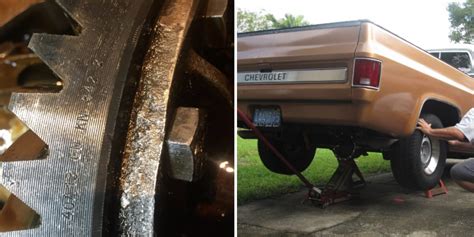Is Your Gear Ratio Off? The Tire Spin Test
Determining the correct gear ratio for your vehicle is crucial for optimal performance and fuel efficiency. A mismatched gear ratio can lead to sluggish acceleration, poor fuel economy, or excessive engine strain. One simple yet effective method for assessing whether your gear ratio is off is the tire spin test. This article will guide you through performing this test and interpreting the results, helping you determine if your gear ratio needs adjustment.
What is a Gear Ratio?
Before diving into the test, let's briefly understand what a gear ratio is. The gear ratio represents the relationship between the engine's rotational speed and the wheels' rotational speed. A lower gear ratio means the engine spins faster for a given wheel speed, providing more torque (power) for acceleration but potentially reducing top speed and fuel efficiency. A higher gear ratio means the engine spins slower for the same wheel speed, resulting in better fuel economy at higher speeds but potentially less acceleration.
Why Perform a Tire Spin Test?
The tire spin test helps you assess if your current gear ratio aligns with your driving needs and vehicle setup. An incorrect gear ratio can manifest in several ways:
- Poor acceleration: If your vehicle struggles to accelerate smoothly, even with a powerful engine, an incorrect gear ratio might be the culprit.
- Excessive engine RPM: High engine revolutions per minute (RPM) at highway speeds indicate a potentially too-low gear ratio.
- Reduced fuel economy: An improperly chosen gear ratio can significantly impact fuel consumption.
- Engine strain: Consistently driving at high RPMs can put undue stress on your engine, potentially leading to premature wear and tear.
How to Perform the Tire Spin Test
This test is best performed on a safe, level surface with minimal traffic. Ensure your vehicle is in good working order, and follow these steps:
- Find a safe, level surface: A large, empty parking lot is ideal.
- Engage first gear: Make sure your vehicle is at a complete stop.
- Apply the throttle smoothly and firmly: Gradually increase the throttle until the tires begin to spin.
- Observe the engine RPM: Pay close attention to the engine speed at the point where the tires begin to lose traction.
Interpreting the Results
The results of the tire spin test are relative to your expectations and driving style. There's no single "correct" RPM at which tires should begin spinning. However, some generalizations can help:
-
Tires spin easily at low RPM: This could suggest a gear ratio that's too low. Your vehicle might accelerate quickly, but at the cost of fuel efficiency and potential engine strain.
-
Tires don't spin easily, even at high RPM: This might indicate a gear ratio that's too high. Your vehicle might feel sluggish off the line and struggle to accelerate effectively.
-
Tires spin at a RPM that feels right: If the tires start spinning at an RPM that seems appropriate for your vehicle and driving style (this is subjective and based on your experience), your gear ratio might be adequately set.
What to Do if Your Gear Ratio Seems Off
If the tire spin test suggests your gear ratio needs adjusting, several options are available:
-
Consult a professional mechanic: A qualified mechanic can diagnose the issue and advise on the best course of action.
-
Consider gear ratio changes: If necessary, adjusting the gear ratio may involve changing the ring and pinion gears in your differential. This is a complex procedure best left to experienced professionals.
Other Factors Affecting Tire Spin
While the tire spin test is a useful indicator, several other factors can influence tire spin:
- Tire condition: Worn or low-pressure tires are more prone to spinning.
- Road surface: A slick or wet surface will make tires spin more easily.
- Vehicle weight: A heavier vehicle might require a different gear ratio than a lighter one.
Frequently Asked Questions
Can I perform this test in higher gears?
While the first gear test provides the most straightforward results, you can repeat this test in higher gears to assess the effectiveness of the gear ratio across different speed ranges. However, the interpretation will be more nuanced as factors like road friction become more significant.
My tires spin easily even with new tires and proper tire pressure. Does this definitely mean my gear ratio is wrong?
Not necessarily. Other factors, such as extremely powerful engines, poor traction on the road surface, or even driver error (aggressive throttle application), could also contribute to easy tire spin. It is best to consult with a professional mechanic for an accurate diagnosis.
How much does it cost to change the gear ratio?
The cost of changing your gear ratio varies significantly based on your vehicle, the type of gears required, and labor costs in your area. It's a significant undertaking that often requires specialized tools and expertise. Contact local mechanics for an estimate.
This comprehensive guide helps you understand the significance of your vehicle’s gear ratio, how to assess it using a practical tire spin test, and what steps to consider if adjustments are needed. Remember, safety is paramount; always perform this test in a safe and controlled environment.

